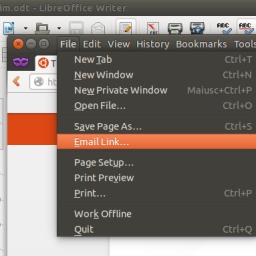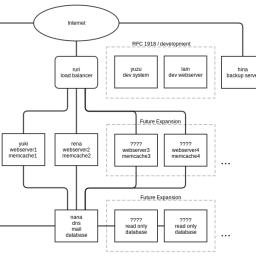
In these paranoid post-NSA times, you'd be forgiven for worrying about the security of your communications. Are your private conversations on Twitter, Facebook or Skype really private, or are they being stored on some shadowy organisations' servers in perpituity? Is something you thought was said in confidence going to come back to haunt you at some unknown time in the future? A lot of developers are asking themselves these kinds of questions, and we're starting to see the emergence of decentralized messaging systems. Here are a couple of these projects which look promising. Although still under active development, they both have clients available which are usable
right now by adventurous alpha testers:
- Project Tox is a FOSS (Free and Open Source Software) instant messaging application aimed to replace Skype. It aims to be an easy to use, all-in-one communication platform (including audio, and videochats in the future) that ensures their users full privacy and secure message delivery. Outlines of the DHT and Lossless UDP protocols used, and a recent post on reddit has more information, and details of different client apps available.
- twister is built on Bitcoin and BitTorrent protocols to deliver a peer-to-peer microblogging system, a secure decentralized alternative to Twitter. The download page has links to source code and Win32 binaries and an installable Android package is available for users who have 'Unknown sources' enabled.
- And while it's not a messing system per se , I2P may also be of interest as an 'anonymous overlay network' which also provides access to secure blogging and email among other features and is available on many platforms .
One thing to bear in mind -- communication software is only as useful as the people using it, so if you want to talk to your friends with either of these, now's the time to start convincing them to adopt...

The wonderful nasaspaceflight.com
reports that the next flight of the
Falcon 9 rocket will attempt a soft water landing. The goal is to test the newly installed legs and confirm that the rocket can touch down in a controlled manner before future attempts at a landing on solid ground. The flights main mission is to resupply the ISS using the Dragon spacecraft. If all goes according to schedule, which it rarely does in the launch industry, liftoff will happen on March 16th.
Borgodoro started to make opensource chocolate inspired by famous opensource projects, the first two had been
VideoLan and
Libav .
The Chocolate recipes are available on github and they have LGPL as "moral license", claiming that this way everybody can make additional recipes out of the chocolate.
The ingredients that make up the chocolate are also available so people has no excuses to experiment and issue pull requests!
 Ars Technica
Ars Technica reports that the next version of Ubuntu (14.04, or
Trusty Tahr ; a Long Term Support Release) will allow users an option to display menu bars inside their parent application windows -- a move away from Mac OSX interface conventions towards the menu placement more commonly used in Windows.
"Despite displaying the menu contents outside of the window, the menus are still window-specific," we noted in a review of Ubuntu 12.04 in May 2012. "By design, the global menu bar displays the menu of the focused window. This proves awkward in some applications with dialogs and multiple windows."
The intended result is to "fix the main UX bug we have [had] in Unity since its very first release: the menus being
hard to find or too far from their parent window ", according to a blog post
Canonical employee Marco Trevisan . "The amount of technical work needed [is] not to be underestimated [...] one of the blockers we had in 12.04 was our dependency on the legacy compiz decor plugin + gtk-window-decorator, that has worked 'OK' in the last years but -- apart from using deprecated technologies (gtk2 in primis) -- it really would have made this concept impossible to realize."
A
tahr appears to be some species of mountain goat indigenous to the Himalayas.

Anandtech is
running an article about a spacious new 5TB enterprise HDD from Toshiba. 3.5 inch, 7200 RPM, 128 MiB, either SATA or SAS 6Gb/s.
Last year, researchers at The University of Nottingham discovered
a new layer in the human cornea. The
latest research from the team shows this new layer, called Dua's Layer, makes an important contribution to the sieve-like meshwork in the periphery of the cornea. Defective drainage in this area is an important cause of glaucoma; a condition that affects 1% to 2% of the world's population.
Professor Dua said: "Many surgeons who perform lamellar corneal transplant recognise this layer as an important part of the surgical anatomy of the cornea. This new finding resulting from a study of the microanatomy of the periphery of the layer could have significance beyond corneal surgery."
For the first time, a team of chemists and engineers at Penn State University
have placed tiny synthetic motors inside live human cells , propelled them with ultrasonic waves and steered them magnetically. It's not exactly "Fantastic Voyage," but it's close. The nanomotors, which are rocket-shaped metal particles, move around inside the cells, spinning and battering against the cell membrane.
"As these nanomotors move around and bump into structures inside the cells, the live cells show internal mechanical responses that no one has seen before," said Tom Mallouk, Evan Pugh Professor of Materials Chemistry and Physics at Penn State. "This research is a vivid demonstration that it may be possible to use synthetic nanomotors to study cell biology in new ways. We might be able to use nanomotors to treat cancer and other diseases by mechanically manipulating cells from the inside. Nanomotors could perform intracellular surgery and deliver drugs noninvasively to living tissues."

Just a quick update on the progress after its first week of life:
- Thursday : registered the pipedot.org domain!
- Friday : setup the DNS and mail servers.
- Saturday : Web, database, and memcache servers built up.
- Sunday : Load balancer added to balance between the two webservers. Also finished setting up the HTTPS certificate and IPv6 support.
- Monday : Initial look, logos, icons and CSS design.
- Tuesday : Database-backed stories (no more static placeholders).
- Wednesday : Login system was enabled.
- Thursday : The first poll was posted late Thursday in time for Valentines Day on Friday.
- Saturday : Topics and the Pipe activated.
- Sunday : Threaded comments and user-submitted stories enabled.
At this point, every page, except for search, is now a
completely real page that renders from the database.
The code base is all new (not based on Slashcode) and using modern web technologies (nginx instead of Apache, no Perl CGI, etc...). There are currently
six servers plus a load balancer with more webservers available to spin up as needed. Sections of code that are either CPU heavy or database intensive (threaded comments) are able to be memcached to maintain performance.
Stay tuned for the next week of updates!
Friends of this website, Soylent News, have been working hard at a similar project: to replace Slashdot from the ground up. Everything is being driven by the community and volunteer work, and they are now working on a business model; truly inspiring. They have
just launched this moment and we want to acknowledge their work.
I used to visit Slashdot quite often, but if Dice Holdings decide to switch the interface to what is currently known as "Beta", I'll have to find another site for my "stuff that matters"-fix.
So, Pipedot, what sites can you recommend for a "maybe-ex" /. user?
 In these paranoid post-NSA times, you'd be forgiven for worrying about the security of your communications. Are your private conversations on Twitter, Facebook or Skype really private, or are they being stored on some shadowy organisations' servers in perpituity? Is something you thought was said in confidence going to come back to haunt you at some unknown time in the future? A lot of developers are asking themselves these kinds of questions, and we're starting to see the emergence of decentralized messaging systems. Here are a couple of these projects which look promising. Although still under active development, they both have clients available which are usable right now by adventurous alpha testers:
In these paranoid post-NSA times, you'd be forgiven for worrying about the security of your communications. Are your private conversations on Twitter, Facebook or Skype really private, or are they being stored on some shadowy organisations' servers in perpituity? Is something you thought was said in confidence going to come back to haunt you at some unknown time in the future? A lot of developers are asking themselves these kinds of questions, and we're starting to see the emergence of decentralized messaging systems. Here are a couple of these projects which look promising. Although still under active development, they both have clients available which are usable right now by adventurous alpha testers:


